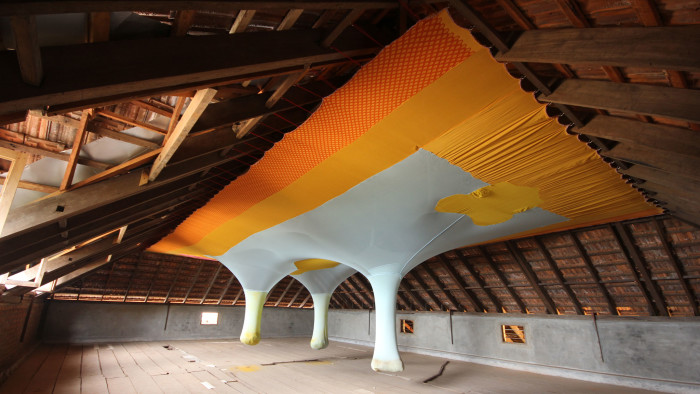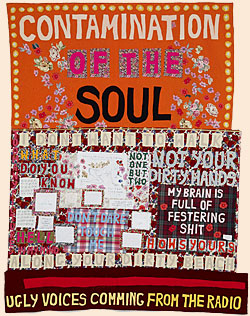Fibre optics

Simply sign up to the Life & Arts myFT Digest -- delivered directly to your inbox.
At 10am on the opening morning of India’s Kochi Biennale, Ernesto Neto is not the only artist to look exhausted. A glut of technical hitches has obliged dozens of participants to work through the night. Yet while others have been involved in alpha-male activities such as hammering, wiring, drilling and sawing, the Brazilian has spent the small hours with a needle and thread stitching up a piece of local sailcloth. The result, a vast pouch stuffed with spices and slung like a hammock from the beams of one of the port’s historic warehouses, is one of the triumphs of the exhibition.
Neto, who represented his country at the 2001 Venice Biennale, and has had solo shows at London’s Hayward Gallery (2010) and in New York at MoMA (2010), is one of a growing number of leading contemporary artists who are using textiles as a key material.
Currently, one of the showpieces of London’s Royal Academy Summer Exhibition is Grayson Perry’s edition of tapestries “The Vanity of Small Differences”, inspired by Hogarth’s “A Rake’s Progress”. Another London crowd-puller is the wall-hanging by El Anatsui that currently adorns Burlington House’s façade. Although it is assembled from bottle-tops and other found debris, from any distance it too looks like a luminous bolt of cloth. Described as a tapestry, its metallic pelt is held together by industrially stitched copper wire.

American portrait titan Chuck Close regularly conjures faces such as that of supermodel Kate Moss, out of jacquard tapestry. Younger artists include the Portuguese sculptor Joana Vasconcelos, whose exuberant rainbow-hued efflorations of stuffed fabric are prized by collector François Pinault; and Shinique Smith, a rising US star due to hold a solo show at the Boston Museum of Fine Arts next year, who transforms discarded clothes into sculptural clouds, bales and collages.
This variety of practices declares that fabric-based art has broken free from stereotypes. In the Renaissance, a colossus such as Raphael had no qualms about making cartoons in preparation for the tapestries that would grace the Sistine Chapel. But the rise of the academies, where artists learnt drawing, painting and sculpture, saw textiles consigned to the camp of decorative arts and design.
Modernism shattered those boundaries. Most famously, Picasso translated “Guernica”, his iconic depiction of war, into tapestry. An exhibition that opens this October at the Musée d’Art Moderne de la Ville de Paris brings together over 100 rugs and tapestries designed by artists as diverse as Picasso himself, Francis Bacon, Alighiero Boetti, Franz West and Rudolf Stingel.
At Christie’s postwar and contemporary art auctions in London this week, fabric-based works included a 1972 tricoloured panel of cotton, “Untitled (3 Colour Fields)” by Italian minimalist Blinky Palermo, an installation by Young British Artist Sarah Lucas involving a pair of embroidered nylon tights, a lightbulb and a coat hanger, and a 1967 Barry Flanagan sculpture of four hessian sacks filled with sand and trailing rope.
“The world is changing,” observes David McFadden, chief curator of New York’s Museum of Art and Design (MAD) where “fibre-based art” (as they term the phenomenon) is key to their collection. “Every generation of artists is more and more focused on the content and less about whether or not you are defining it as decorative or fine arts.”

Despite the plethora of male artists who have worked with cloth, textile art is still often regarded as an essentially female medium. “Joseph Beuys worked with felt, but no one regards him as a fibre-based artist,” McFadden points out. Instead, textile art is associated with female artists such as Louise Bourgeois, Kiki Smith and Tracey Emin, who adopted techniques and materials such as embroidery, sewing, latex and quilt-making as vehicles through which they could give voice to feminist rage.
Those practices are decreasingly seen as a female province. McFadden has put on two exhibitions, Radical Lace and Subversive Knitting (2007) and Pricked: Extreme Embroidery (2007-08) that included a number of male artists. In 2010, an exhibition entitled Men of Cloth at the Waterside Arts Centre in Manchester featured six male textile artists ranging from Kazuhito Takadoi, who fuses basketwork and embroidery, to Michael Brennand-Wood, who specialises in computerised embroidery.
The past decade has seen a rise in the number of artists, both male and female, who are choosing fabric for qualities beyond the emotional and intimate. “I don’t think there are any boundaries any more,” says Victoria Miro, who represents both Grayson Perry and Brazilian artist Maria Nepomuceno, who creates elaborate sculptures out of rope, straw and beads – sculptures that simultaneously evoke the local weaving tradition of Latin America but also transcend it to become spectacular formal statements in their own right. “If it suits them, and it’s right for their work, I don’t think they have the prejudices of former times,” Miro adds.

Take Korean artist Do Ho Suh, whose “Staircase-III”, a staircase in scarlet gauze, occupied the ceiling of one of Tate Modern’s fifth-floor galleries from March 2011 to May 2012. For Suh, the appeal of fabric lies not in any expressive nature but in its practical characteristics.
“The choice of fabric came very naturally to me,” he explains in a film on the Tate’s website. “You can pack it in your suitcase. It’s about mobility and transportability. Also [it] is very transparent, so you can see the space through the piece and that helps gallery visitors see the space in a different way.”
Certainly, the nature of much fabric – its fluidity, tactility and capacity for potent colour, for example – sets it apart from other materials. What captivated Royal Academy curator Edith Devaney when she first saw one of El Anatsui’s tapestries hanging on the façade of the Palazzo Fortuny in Venice was “the way it draped, the relationship it had with the building. A sculpture couldn’t do that.”
Grayson Perry’s tapestries, she explains, were chosen for the Summer Exhibition’s final room because “people are on their knees by then and need something that is going to challenge them in a new way”. The tapestries have, she says, transformed the space. “There’s a richness to them. A depth of colour and three-dimensional quality. It gives the gallery a new warmth.”
In terms of the market, prices vary widely. A tapestry by El Anatsui sold at Christie’s New York last year for $1,179,750. One of Tracey Emin’s large-scale quilts, “It’s the Way We Think,” (2004) fetched £157,250 in 2010 at Christie’s in London. Christie’s have estimated Blinky Palermo’s colour field at £800,000 to £1,200,000.

These are unique pieces. However, digital technology allows artists such as Perry, Chuck Close and Tracey Emin to produce (and reproduce) tapestries and embroideries in multiple editions. As a result, Emin’s embroidered cotton handkerchiefs are selling on the secondary market for less than $1,000. A Chuck Close tapestry of Kate Moss, the fifth in an edition of 10, fetched £66,500 at Phillips de Pury in 2008, while his “Phil”, part of an edition of 50, sold for $6,875 at Sotheby’s earlier this year. The tapestries in Perry’s “Vanity of Small Differences” series were produced in editions of six and sold for £55,000 each. (His pots, which are unique, sell for closer to £100,000.)
Most dealers agree that collectors are attracted less by the medium than by the individual work and artist. “It’s people who are interested in Grayson’s work rather than people who are interested in tapestries,” Miro says of Perry’s buyers.
The success of “The Vanity of Small Differences”, which has only two pieces left, has confounded her expectations. “I had doubts that it would be hugely commercial but we had queues going around the gallery and we had to open on a Monday when we are usually closed,” she recalls.
Those Renaissance popes would be less surprised.
——————————————-
Read Simon Schama in conversation with Grayson Perry
Comments